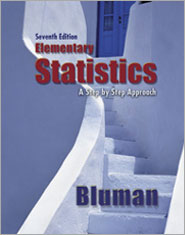
Elementary Statistics (Bluman), 7th EditionTable of ContentsIntroduction 1.1 Descriptive and Inferential Statistics 1.2 Variables and Types of Data 1.3 Data Collection and Sampling Techniques 1.4 Observational and Experimental Studies 1.5 Uses and Misuses of Statistics 1.6 Computers and Calculators Summary Chapter 2: Frequency Distributions and Graphs Introduction 2.1 Organizing Data 2.2 Histograms, Frequency Polygons, and Ogives 2.3 Other Types of Graphs Summary Chapter 3: Data Description Introduction 3.1 Measures of Central Tendency 3.2 Measures of Variation 3.3 Measures of Position 3.4 Exploratory Data Analysis Summary Chapter 4: Probability and Counting Rules Introduction 4.1 Sample Spaces and Probability 4.2 The Addition Rules for Probability 4.3 The Multiplication Rules and Conditional Probability 4.4 Counting Rules 4.5 Probability and Counting Rules Summary Chapter 5: Discrete Probability Distributions Introduction 5.1 Probability Distributions 5.2 Mean, Variance, Standard Deviation, and Expectation 5.3 The Binomial Distribution 5.4 Other Types of Distributions (Optional) Summary Chapter 6: The Normal Distribution Introduction 6.1 Normal Distribution 6.2 Applications of the Normal Distribution 6.3 The Central Limit Theorem 6.4 The Normal Approximation to the Binomial Distribution Summary Chapter 7: Confidence Intervals and Sample Size Introduction 7.1 Confidence Intervals for the Mean When σ Known and Sample Size 7.2 Confidence Intervals for the Mean When σ Unknown 7.3 Confidence Intervals and Sample Size for Proportions 7.4 Confidence Intervals for Variances and Standard Deviations Summary Chapter 8: Hypothesis Testing Introduction 8.1 Steps in Hypothesis Testing – Traditional Method 8.2 z Test for a Mean 8.3 t Test for a Mean 8.4 z Test for a Proportion 8.5 x2 Test for a Variance or Standard Deviation 8.6 Additional Topics Regarding Hypothesis Testing Summary Chapter 9: Testing the Difference Between Two Means, Two Variances, and Two Proportions Introduction 9.1 Testing the Difference Between Two Means: Using the z Test 9.2 Testing the Difference Between Two Means: Independent Samples using the t Test 9.3 Testing the Difference Between Two Means: Small Dependent Samples 9.4 Testing the Difference Between Proportions 9.5 Testing the Difference Between Two Variances Summary Chapter 10: Correlation and Regression Introduction 10.1 Scatter Plots and Correlation 10.2 Regression 10.3 Coefficient of Determination and Standard Error of the Estimate 10.4 Multiple Regression (Optional) Summary Chapter 11: Other Chi-Square Tests Introduction 11.1 Test for Goodness of Fit 11.2 Tests Using Contingency Tables Summary Chapter 12: Analysis of Variance Introduction 12.1 One-Way Analysis of Variance 12.2 The Scheffe Test and the Turkey Test 12.3 Two-Way Analysis of Variance Summary Chapter 13: Nonparametric Statistics Introduction 13.1 Advantages and Disadvantages of Nonparametric Methods 13.2 The Sign Test 13.3 The Wilcoxon Rank Sum Test 13.4 The Wilcoxon Signed-Rank Test 13.5 The Kruskal-Wallis Test 13.6 The Spearman Rank Correlation Coefficient and the Runs Test Summary Chapter 14: Sampling and Simulation Introduction 14.1 Common Sampling Techniques 14.2 Surveys and Questionnaire Design 14.3 Simulation Techniques and The Monte Carlo Method Summary Appendix A: Algebra Review Appendix B-1: Writing the Research Report Appendix B-2: Bayes’ Theorem Appendix B-3: Alternate Approach to the Standard Normal Distribution Appendix C: Tables Appendix D: Data Bank Appendix E: Glossary Appendix F: Bibliography Appendix G: Photo Credits Appendix H: Selected Answers Index |  |















